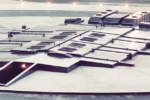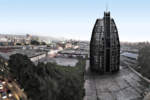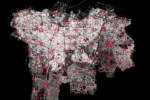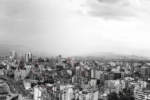Beirut and Memory
Nicola Santini: What do you think is the role of architecture in the recovery or mystification of memory in Beirut and what role your architecture plays in this perspective?
Bernard Khoury: The question of memory was to me an extremely important once back in the early nineties. At that time I had hopes of a great reconstruction project of rebuilding of a nation. But I would say, fifteen years later, that Beirut was not rebuilt. It is more complicated than that: Beirut was in perpetual development. In the post-war period of the early nineties, there was not reformulation of a common history, there was not reformulation of a common memory. We went through, what I call “the denial period”. The denial period consisted in putting things under the carpet and in 2005 the carpet blowed up. It‘s a very sad story if Hariri disappeared. I would say there was a project, Hariri was a project, with all his greatness and all his failures. It was the only project that tented a sort of a consensus but it never really faced the very relevant problems that were put under the carpet.
To me this “post-war” was not clearly a post-war period. I did a project in 1991 called “Evolving scars”. And it was about the scaring of the cities through the disintegration and the demolition of buildings. I look back at that work twenty years later and I realize that it was politically very naïve because it raise the question of scaring, a question you can only raise if you are willing to raise the question of history and memory besides and beyond architecture and it was never raised. History stops in history books in 1975. This issue of memory became impossible to raise, at least as a collective exercise. I realized many years later; it took me until 1998 to be able to build my first intervention but strangely was the entertainment industry, and it was a stupid nightclub to begin with. It was not a museum, not a memorial, not public housing, it was not an opera house. I never did a public building. I was going through the practice of building through entertainment industry and through temporary buildings. And I raised the question of memory trough these projects.
But I like to talk about these projects much more in the present rather than as memorial of the past: B018 is more about bringing life and about the impossibility of its existence at this particular moment in that side of the city. Same thing for Yabani and Central.
And I think the most relevant thing about B018 is to hear its sound at 3 or 4 in the morning, in an area which is completely desert, which is dead, which has been bypassed by the sprawling of the city. B018 is more about bringing life, is much more about the impossibility of it‘s existence at this particular moment in that side of the city, same thing for Yabani and same thing for Central, that‘s why they became more complex than just a rhetoric memorial.
Preserving urban voids
N.S.: What about the fact of building underground in your early projects?
B.K.: If you look at B018
as a gesture, it was predominantly about preserving the void.
The project area, called Quarantine, which is completely empty, it was a Palestinian camp. You see the contrast between these two areas: the very dense fabric on one side of the highway and the complete emptiness on the seaside. I didn‘t want to add matter. I think the absence of matter made the project even more visible. I like the notion of the building that is invisible during the day as it went to sleep and wake up at night just through reflections of lights and sounds to the sky and the neighborhood around which is deserted. For the Yabani was a very pragmatic choice. At the beginning, it was impossible to eat sushi at 50 dollars when the building next door was squatted by workers that were living without windows. Now things are changed. Twelve years later the building was renovated. There are other bars and clubs around it, but when I built it was cataclysmic all around it. It was pragmatically impossible to expose the guests to the immediate environment.
So by pulling them below the ground, and doing it so forcefully and consciously, and by playing with their behavior from the arrival to the over exposure in the arrival, trough this cylindrical tube that sucs you down and seals you completely from the outside and gives you the sky, and nothing but the sky, I think the gesture was so forceful and one cannot but be aware of this strange situation.
Engaging with the city
N.S.: I think your buildings interpret and reflect the spirit of Beirut in an original and enigmatic way. Can you talk about this particular relationship between architecture and urban environment in your work?
B.K.: I think it‘s because of this obsessive quest of the very specific. I think in every situation one can be extremely specific. I think my work is not contemplative. I don‘t think my work is about representation. I‘d like to describe my work as devices, even the residential ones, they perform very specific tasks and they try to provoke certain behaviors, whether when it‘s about entertainment in the street, whether it‘s about going to have a drink in a bar, or whether it‘s about inhabiting an apartment, waking up in the morning, walking along the façade, grabbing a cup of coffee at the kitchen, going down to see your parents and going back in the living room without even walking inside your apartment. It‘s a relationship with the city. My projects are engaging with their environment rather then talking about. They provoke reactions, they engage the city, they engage the streets, and I think that is very Mediterranean to do that. We live outside, we have the best climate in the world and culturally we always engaged with surroundings. And it‘s always, and in particular in the residential projects, a great deal of resistance to an imposed typology. A typology that was imposed on us.
And I dare you to find in the last 35 years one building that broke that model: the central core, which is blind in the middle, the reception in the front, the living room around left and right the central core, the bedrooms in the back that you access with blind corridors. So when you come and you completely bombard, bomb out and destroy that typology and explode your plan you give the option of travelling in your apartment through its periphery with very narrow slabs, it‘s a relationship with the city that you start to establish. When you fight to land outside, out in the air, in most of the plan that you deliver, which is completely against the rules of the developers here, and you manage to succeed and your apartments end up selling better, faster, and more than the typical developers plan, you have broken the wall.
Form and performance
N.S.: There is a “fil rouge” that is linking all your projects, but it‘s not about form, nor about language. Can you talk about it?
B.K.: There is something but it‘s not about their morphology. It‘s not the syntax. It‘s not the grammar. I think it‘s an attitude and they are very specific and would not have happen in Paris, in Berlin or in Rotterdam, they would have only happen here in Beirut. They are devices that have a great deal with precision, they are conceived to perform their tasks. I guess you can compare it sometimes with the rigor of the military machines.
Beirut identity
N.S.: Beirut seems a multilayer city; I would say a multi-identity or a latent identity city. How contemporary architecture deals with this fluctuating and at the same time heavy identity? B.K.: The question of identity is very sensitive on here because it is very difficult to even formulate or discuss about identity when there is no political consensus, no consensus about history or even no debate around that. I‘ve given up on trying to work or represent an identity that is frozen in the lack of the consensus. I think I‘d rather been contextual, obsessively contextual in every single task I‘ve given when I‘m totally engaged to the situation to the extreme without worrying to represent some sort of local flavor or some sort of consensual image. At my eyes, all those that tried to do that ended up with dangerous simplified mimics of history or identity. And that‘s the problem of the westerns coming to Beirut and trying to do a local project, because they fall in the cliché and when they do that in Qatar or in Abu Dhabi and Dubai, it‘s the same story, it becomes a transvestite or sort of it. I think we should look for a modernity that comes from within.









